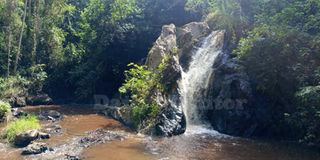The untapped beauty inside Buhweju

The magnificient view of Kijonjo falls located in Karungu Sub county. PHOTOS/ ZADOCK AMANYISA
What you need to know:
- It takes some courage to climb the hills. Ascending the slopes is even creepier, especially for first time visitors.
Ever since the Covid-19 induced lockdown was lifted, I have had an opportunity to move from district to district on several expeditions.
Located in the south-western part of Uganda, Buhweju District was split from Greater Bushenyi in 2010.
Entering Buhweju
The roads to Buhweju are quite bumpy. If you like comfort, be warned that the terrain is rugged.
From every entry point into Buhweju, one hears the sound of gushing water. That is why it is the source of River Rwizi, which straddles the Ankole Sub-region before pouring into River Kagera.
Lush green hills
Buhweju is made up of gentle sloping hills, rocky topography and lightly rolling valleys with minor vertical cliffs. It takes some courage to climb the hills. Ascending the slopes is even creepier, especially for first time visitors.

Water falls
In its V-shaped valleys, Buhweju has a variety of waterfalls, including Mukazi Anyara, Kijonjo and Engaju.
Nature lovers can explore the Kasyoha-Kitomi Forest Reserve. Situated 35 kilometres from Bushenyi Town, it stretches over 433 square kilometres. The forest is a haven for several primate species such as Chimpanzees, blue monkeys, Red-tailed monkeys, Olive baboons, Vervet monkeys, Black and white Colobus monkeys and Red Colobus monkeys. It is also home to breathtaking crater lakes such as the twin Lakes of Kamweru and Kyema and the temporary Lake Kamunzuku.
The hills of Buhweju kind of form a kind of canopy. Some areas receive the sunshine at midday especially during the months of March-May and September-November. In the morning, the tea plantations are covered with clouds.
Mining activities
Buhweju is endowed with minerals, gold taking the first place. According to historical sources, Buhweju goldfield was first discovered in 1933, but mining began a year later. The business was, however, interrupted by the Second World War and the subsequent independence struggle of 1962.
There are no trained guides to share the history of the mining, but the artisanal miners are willing to share their experience.
Cultural history
The Bachwezi dynasty was dominant in Buhweju and to-date many families in Buhweju venerate Bachwezi with majority of them having mini shrines in their homes. Items or regalia associated with Bachwezi can be found in rocky caves known as enyanga z’amabare and these are also tourist attractions.
Training in military science was one of its strengths as a state, which enabled it to retain its independence from subjugation by the Bunyoro, Nkore, and Mpororo kingdoms during the federal days.
Initially, Buhweju was a kingdom ruled by an Omukama but it was later incorporated into the British Ankole protectorate in 1901.
In his article, The Buhweju Heroes, Nathan Mwesigye Byamukama says Buhweju had existed for many years as a self-sustaining kingdom before the arrival of colonialists.
Kishungwe hill
At Kishungwe hill, the King of Buhweju, Ndagara, together with his son Nyakiiga and other warriors were shot dead by the British before merging Buhweju with Nkore after they put up stiff resistance to colonialism in fear of being subjected to slavery.
King Ndagara’s son and heir to the throne, Ndibarema was carried away by the British, but they later returned him to the kingdom. He was coerced to sign an agreement to be part of the Ankole Kingdom.
Buhweju had a number of cultural sites in Kasharara and Kyamujuni, some of them dilapidated, but the history can be reconstructed.
King’s escape tunnels
The Omugabe’s escape tunnel routes were dug from Bisya–Kyakangire through Mushasha to Rubindi, Kashari in Mbarara City.
Another ran from the foothills of Kyamujumi-Kasharara, opening through Bukiro, also in Kashari in Mbarara. The king would use these escape tunnels whenever he sensed danger.
Hospitable
Bitysa and Nsiika areas played an important role in the National Resistance Army bush war by providing sanctuary and food for the fighters. The two places are also known to have hosted training grounds for the army.

At Bitsya Primary school lie the remains of fallen NRA fighters. In 1984, the terrain provided a natural shield to the trainees and fighters. Today, the ridges provide a good environment for hill climbing and sight-seeing experiences.
Production
Tourists are also given an opportunity to learn how millet bread- karo, the staple food, is prepared and served.
Being a banana growing district, Buhweju produces bananas that can be ripened, and squeezed to produce juice, which is then taken through a distillation process to make Waragi.
Waragi gin is a generic term for domestic distilled banana beverages. Tourists can visit communities and observe the distillation process. Large distillation points can be seen on the roadsides in areas of Rugongo in Karungu Sub-county.
Accommodation
Buhweju does not have adequate accommodation for tourists. Travellers improvise by sleeping in tents.
Despite the poor infrastructure, people are hospitable. If explored and documented, Buhweju’s attractions can serve as a stopover for tourists travelling from Kampala and Entebbe to Queen Elizabeth National Park.
According to Deo Atuhaire, the Buhweju district chairperson, the district does not earn from its endowments. He says nothing has been done to gazette the tourist attractions and market them to the world.





